
If you haven't been hiding under a rock — and at the thought of this particular fungus, who wouldn't be? — you've probably seen or heard of the new HBO hit series "The Last of Us," an apocalyptic nightmare based on the 2013 video game of the same name. The series creepily centers on a group of people left to survive after an Ophiocordyceps fungus evolves to infect humans. You can probably guess the rest, but read on and fear not — we won't be providing any spoilers here.
Zombies are scary for a reason — for many reasons, actually. But one reason is that we humans like the idea that we control our own behavior, which is something zombies ostensibly can't do.
Advertisement
In horror movies, a zombie is just a regular human whose brain gets hijacked by some illness that turns the regular human into a monster. We don't know of any illness that does this in humans to the extent of zombification — although the single-celled parasite Toxoplasma gondii might be more brain-altering than we know — but some other animals on Earth are in danger of getting full-body hijacked by a mushroom.

